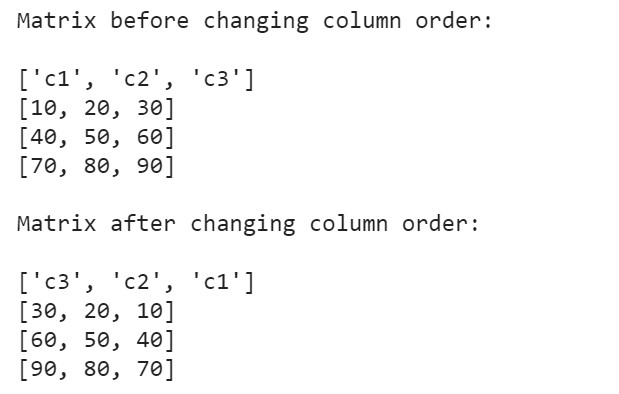How to reverse column order in a matrix with Python?
Last Updated :
08 Sep, 2021
In this article, we will see how to reverse the column order of a matrix in Python.
Examples:
Input:
arr = [[10,20,30],
[40,50,60],
[70,80,90]]
Output:
30 20 10
60 50 40
90 80 70
Input:
arr = [[15,30],
[45,60],
[75,90],
[105,120]]
Output:
30 15
60 45
90 75
120 105
Matrices are created in python by using nested lists/arrays. However, a more efficient way to handle arrays in python is the NumPy library. To create arrays using NumPy use this or matrix in python once go through this.
Method 1:
- Iterate through each row
- For every row, use list comprehension to reverse the row (i.e. a[::-1])
- Append the reversed rows into a new matrix
- Print the matrix
Example:
Python3
matrix_1 = [['c1', 'c2', 'c3'],
[10, 20, 30],
[40, 50, 60],
[70, 80, 90]]
matrix_2 = []
for i in range(len(matrix_1)):
matrix_2.append(matrix_1[i][::-1])
print('Matrix before changing column order:\n')
for rows in matrix_1:
print(rows)
print('\nMatrix after changing column order:\n')
for rows in matrix_2:
print(rows)
|
Output:

Method 2:
An array object in NumPy is called ndarray, which is created using the array() function. To reverse column order in a matrix, we make use of the numpy.fliplr() method. The method flips the entries in each row in the left/right direction. Column data is preserved but appears in a different order than before.
Syntax: numpy.fliplr(m)
Parameters: m (array_like) – Input array must be at least 2-D.
Returned Value: ndarray – A view of m is returned with the columns reversed, and this operation’s time complexity is O(1).
Example:
Python3
import numpy as np
arr = np.array([
['c1', 'c2', 'c3'],
[10, 20, 30],
[40, 50, 60],
[70, 80, 90]])
flipped_arr = np.fliplr(arr)
print('Array before changing column order:\n', arr)
print('\nArray after changing column order:\n', flipped_arr)
|
Output:

Flipped_arr contains a reversed column order matrix where the column order has changed from c1,c2,c3 to c3,c2,c1, and the elements of each column remain intact under their respective headers (c1,c2,c3).
Like Article
Suggest improvement
Share your thoughts in the comments
Please Login to comment...